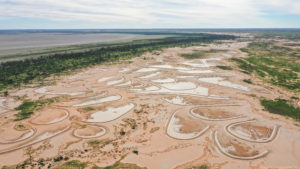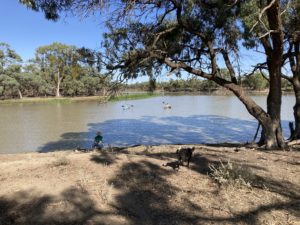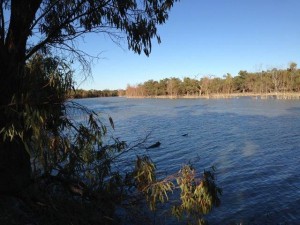May 29, 2022

While there is good growth after the rain, there is still lots of bare soil that will allow water to run off, lots of opportunities to improve
This is a question that we constantly ask ourselves and always strive to improve the way we value our precious rainfall. This is exactly the type of question we are asking ourselves now (we have received 90+mm in the last 5 weeks), we had a good rest while it was dry, now is the time to get active and make sure we value the precious rain we have received. This can be viewed on a number of levels; infiltration into the soil, diversity of plants, amount and class of livestock grazing it and turnover of those stock.
Infiltration:
I reckon this is the most important issue here, first up you must be able to allow water into the soil at whatever rate it falls so that it can grow pasture without running off first, this is the most efficient use of rainfall. For this to happen you really need effective ground cover of vegetation as well as organic matter in the soil (carbon is a part of this), both these issues allow the soil to absorb high rates of rainfall. There are places that might need some mechanical intervention to aid the infiltration of water, at least until there is adequate vegetation to enable the natural processes to absorb the water. To harvest and best use the water that is now stored in the soil, diversity of plant species is important, so that whenever rain falls something is growing and able to use that moisture before it drops out of the root zone.
Plant diversity:
As said above, plant diversity is so very important so that you can harvest soil moisture at any time of the year. For good plant diversity you need as much diversity through your land and livestock management system as possible. By this I mean grazing paddocks at different times of the year, with different species of livestock, different classes of livestock, different grazing intensities and length of grazes. This can make management more complex, to instil some chaos in a planned system can be difficult to organise and enact.
Diversity of Livestock:
In a livestock business we have been told that you need to find out what you do well and do more of it, simple really. Under an extremely variable climate, like what we find ourselves in now, what you do well might change from year to year. While breeding livestock, especially small animals (sheep or goats) in the Southern Rangelands is normally the most profitable, that isn’t always the case. What value might we place on improving water infiltration? With this in mind having flexibility in your options, being able to manage different species, goats, sheep, cattle and different classes in the species, growing young stock, older dry stock to go with the breeders, means you can cater for most eventualities. This doesn’t mean you have small mobs of different types of stock all over the place, just might mean you have to ability to bring in a different species or class of livestock that is suited to the plants you have in your landscape. This is about harvesting the plants and having stock to sell, turning the rain into plants, into money.
Turnover, sale of stock:
Having access to a diverse range of livestock means that you can utilise the moisture and plants available, having a mix of grazers and browsers with the plant diversity to suit means that plant utilisation can be optimised. Then the inevitable happens, the stock aren’t “finished, they aren’t ready for sale”, with the access to many sale options, livestock are always ready for sale. There is always someone looking for a store article to finish, as they have a different class of feed that can take these animals to the next level. It is usually a very smart option to sell stock once they have stopped putting on weight and you think by keeping them you could risk their health and/or the health of your landscape.
Now I’m aware not everyone lives in a rangeland environment and has access to such a diverse range of plants, enabling the running of a diverse business. Which comes first though, the diverse plants enabling this to happen, or the diverse management allowing a diversity of plants to grow?

Sometimes diversity of grazing management isn’t enough, you may need mechanical intervention
May 22, 2022

I know intrinsically everyone values the environment, that is something that we have wonderful personalities such as David Attenborough to thank for making us all more aware. What I’m talking about is at a much more basic level, we value our property, our house, our car, even our time, so what value do we place on the wonderful bushland where you walk through nearby? Or the array of native parrots that fly overhead calling to their mates?
Our property is in South West NSW, with our house adjacent to the Anabranch/Talyawalka River (Part of the Lower Darling River). Water normally flows into the river from either Darling River floods or controlled managed flows from the Menindee Lakes scheme. The current flow is a combination of a managed flow out of Lake Cawndilla and an overland/spill flow from the Darling/Baaka.
The specific issue that I wish to discuss is there have been a couple of recent opportunities to deliver a small flood to the lower Darling River (Between Menindee Lakes and Wentworth) in order to water more of the floodplains and deliver a wonderful fish breeding/feeding event (Not to mention all the trees and plants that are watered!) that the area really needs after large sections dried up in 2019. Every centimetre increase in river height over the high flow level of approx. 18,000mgl/day results in more floodplain inundated, more trees and plants watered, more food for river life, fish, frogs, yabbies, turtles etc.
Unfortunately, a decision by Water NSW was unable to happen due to the State Emergency Services (SES) expressing concerns about possible inundation of some river shacks and potential property damage. I express no ill feeling towards anyone in the SES, in fact if I was in their position and could be held accountable for property damage, then I may well have made a similar decision. The ruling is that if “we can mitigate a flood we must mitigate a flood”. The question that I have is; “why do we say that our man made property trumps the environment every time, then we are left trying to repair our precious environment?” I reckon we need a much more balanced perspective on issues such as this, especially if we are to turn around the decline in our inland rivers and streams.
The risk seen in the above example was damage to property, what wasn’t reconciled was impact to the environment by not taking this missed opportunity. How would we cost out the impact to the flora and fauna in the riverine environment, especially those that directly benefit from the floodplains? You will note that I talk about the river and the floodplains, they are two parts of the one system; The river is the main channel and is the critical habitat when there are low or no flows. Then there is the floodplains where all the food is generated, the signal to breed is when the rivers spill into the floodplains, so important to not miss these breeding and watering opportunities.
I’m a farmer and I consider myself a proud caring one, it is fantastic that we are beginning to account for important issues such as biodiversity, carbon and Natural Capital. That is much more accurately accounting for the impact food and fibre production can have on the environment, good and bad. Every action has a reaction, there are winners and losers in every decision we make, the aim of resource managers is to maintain or preferably build that resource over their time. As decision makers, managing a water storage is no different. This is a component of a larger river system and the aim must be to improve the whole riverine corridor, while delivering water to the communities along the river.
In the last couple of months there has been significant flooding through many communities, especially near the coast in NSW and QLD. What impact has town and community planning had on river flows in these areas? What impact has management of farming land had on the infiltration of water into the soil? Are the impacts of these actions even accounted for? Was the value to the environment of the flood actually recognised, the fish breeding opportunities? Many questions that if we are to genuinely take our environment seriously, I reckon we need to address.
In closing I reckon we need to make our decisions around water management more complex, better communicated and more transparent. Our inland regional communities rely on these rivers, the lifeblood of the area, for economic, social and cultural reasons. The Indigenous people in our area, the Barkindji People refer to the Darling River as the “Baaka”, to them it was the lifeblood. Our culture has only been here 230 odd years and I hope we are starting to learn that.





